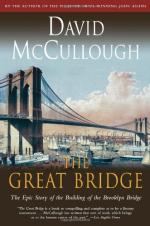|
This section contains 638 words (approx. 2 pages at 400 words per page) |

|
The Great Bridge Summary & Study Guide Description
The Great Bridge Summary & Study Guide includes comprehensive information and analysis to help you understand the book. This study guide contains the following sections:
This detailed literature summary also contains Topics for Discussion and a Free Quiz on The Great Bridge by David McCullough.
The Great Bridge links politics, engineering and human drama in telling the epic story of the building of the Brooklyn Bridge, from 1869 to 1883.
Realizing each community stands to benefit from a land link between them, Brooklyn and Manhattan politicians obtain from the New York Assembly a charter for a private company to build a bridge. They appoint Henry Murphy, former mayor of Brooklyn, to President of the New York Bridge Company, and the renowned engineer, John A. Roebling of Trenton, NJ, as Chief Engineer. To win support for his plans, Roebling accompanies engineers and politicians on a train tour of his three previous triumphs at Pittsburgh, Cincinnati, and Niagara Falls. They are so impressive and so well illustrate the concepts he will use in Brooklyn, that work finally gets under way. Roebling again takes as his assistant his son, Washington, a graduate of America's premier engineering school. He was also a Civil War veteran, and supervisor of wire spinning on the Cincinnati job. Wash has also spent a year in Europe, studying the latest developments, including the use of pneumatic caissons as underwater footings for suspension bridges.
John A. Roebling dies of a job-related accident, leaving only Wash as a possible successor. He is appointed Chief Engineer, hires a staff, completes specifications and plans, and sets to work on the Brooklyn caisson, at the size of a city block, easily the largest yet attempted. The East River is highly irregular on the Brooklyn side, and many obstacles slow the work. When it is finally complete, the stone tower begins to rise, giving the public a sense of progress and hope.
The New York caisson incorporates features experience suggests will improve performance, but bottom conditions are far better and progress is brisk. Soon the caisson reaches a depth where workers suffer "the bends," a mysterious, debilitating, and occasionally fatal malady. Roebling, who contracts it twice, takes a calculated risk in settling for a sand-and-gravel footing short of bedrock, which doubtless saves lives. The New York tower soon begins rising towards the sky.
Roebling never recovers his health, and as the less challenging task of masonry goes forward, he retreats to Trenton. He continues directing work from his sickbed, largely through his remarkable wife Emily. After the towers and anchorages are built, it is expected John A. Roebling's Sons wire factory will provide materials for the next phases - spinning cables on-site. Politics, however, intervene as Boss Tweed falls in Manhattan and reveals the shady deeds that accompanied the original chartering of the Bridge Company. Reformers join the board, move to amend the charter to make it a public company run by trustees and subject to higher standards of accounting. Brooklyn leaders, however, want to keep profits in their county and finagle the $1 million wire contract going to J. Lloyd Haigh, who bilks $300,000 in illegitimate profits on defective wire delivered to the website. Roebling is targeted not only for conflict of interest but also for physical and mental inability to continue leading the project. Several times the recluse is angered to the point of resigning, but Murphy each time diverts a crisis. Brooklyn Mayor Seth Low narrowly loses a bid to fire Roebling, when he refuses to resign and become a paid consultant. Emily's calm diplomacy and mastery of the engineering are a major factor in the ultimate success of the project. Fittingly, she drives the first carriage across the span and hosts the President and Governor at a gala reception on opening day, an event remembered by Brooklynites for as long as they live.
The Great Bridge is a triumph of engineering, an inspiring work of architecture perfectly fitted to its environment and task. It becomes part of American folklore. It lives up to all its founders' visions, even as Brooklyn and Manhattan changed radically.
Read more from the Study Guide
|
This section contains 638 words (approx. 2 pages at 400 words per page) |

|



